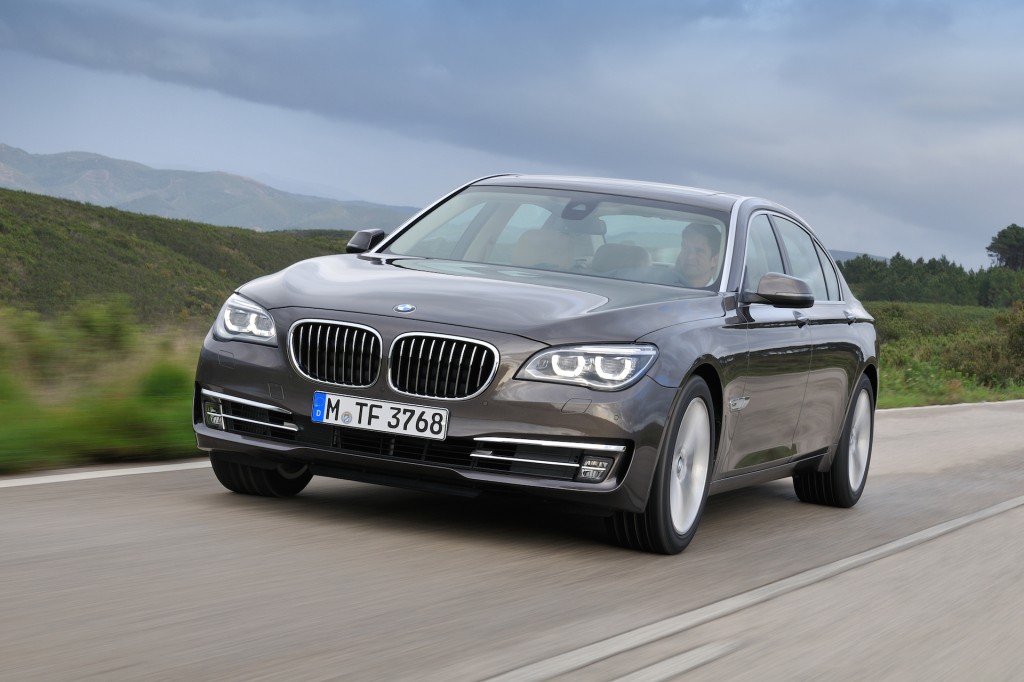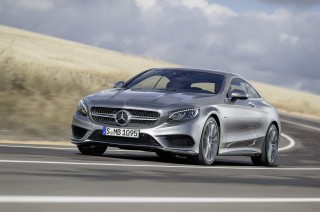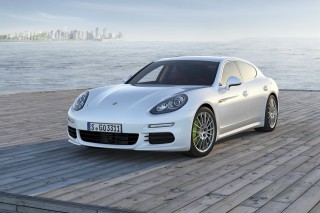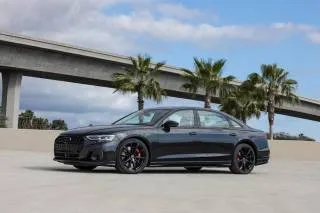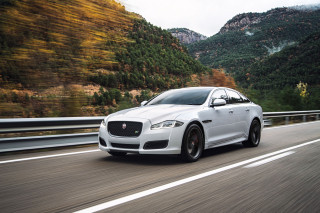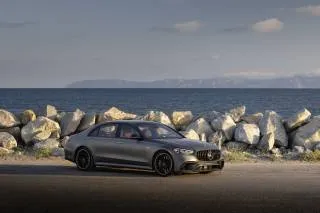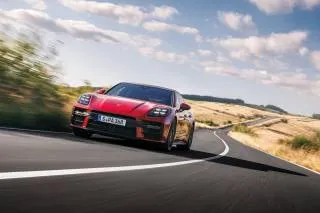Likes
- Strong powertrains
- Formal yet athletic appearance
- Many chances to upgrade
- Back seat comfort better than a limo (iL)
- Handles well for a large luxury car
Dislikes
- ActiveHybrid 7 should be smoother
- Tech overload
- Interiors without upgrades feel stark
Buying tip
features & specs
The 2015 BMW 7-Series is exceptionally quick and technologically advanced, but also very luxurious and wonderfully comfortable.
The 2015 BMW 7-Series is the German luxury brand's flagship vehicle and one of the most technologically advanced sedans in the world. It hasn't seen any major redesign in more than five years, yet BMW has fed it a constant stream of updates to keep it relevant. This year it gains a diesel model plus leather dashes for all, and LED headlamps in V-8 models.
There are six different powerplants offered in the 2015 BMW 7-Series—740i, 750i, 760i, Active Hybrid 7, the top-performance Alpina B7, and the new diesel-powered 740Ld xDrive. All of these models include standard rear-wheel drive—with exception to the diesel's standard all-wheel drive–and many offer all-wheel drive, too. While those who appreciate the 7-Series' sport-sedan pedigree will be able to parse out (and appreciate) the finer differences between these models, across the board you'll surely find that the 7-Series models accelerate swiftly, with amazing grip and more poise from a vehicle this size. These are for the most part surprisingly satisfying sedans for the driver, although comfort, luxury, and tech are at the top—and that also shows more for some models than others.
The 2015 BMW 740i and 740Li are the base models in the lineup; they come with a version of BMW's twin-turbo in-line six, making 315 horsepower and 330 pound-feet of torque. These models are more than 200 pounds lighter than V-8 versions, so you might find handling more nimble and enjoyable as well. 750i and 750iL models step up to V-8 engines that were all-new last year. The twin-turbo, 4.4-liter V-8 makes 445 hp and 480 lb-ft of torque, and these models can charge to 60 mph in an automaker-cited 4.7 seconds. The 760Li might sound like one of the performance leaders of the group—and it is, with 537 hp from its twin-turbo V-12--but it's the portly one in the lineup. The true athlete here is the performance-focused Alpina B7, which has a special version of the V-8 underhood that makes 540 horsepower and 538 pound-feet. In addition to that, you get a suspension that's firmer than any of the other models can manage in Sport mode, as well as bigger brakes, and other enhancements. The 0-60 mph time is just 4.5 seconds here. The all-new 740Ld xDrive is powered by a 3.0-liter turbo-diesel inline six, capable of producing 255-horsepower and a hefty 413-lb-ft of torque. That motivates the diesel 7er from 0-60 in 6.1 seconds.
All versions get an air suspension, plus Driving Dynamics Control, a system that governs shock firmness, steering heft, transmission shifts, and throttle response--but allows drivers to twiddle with the settings to fit their habits. The only thing we're left wanting is steering feel that isn't so artificial.
Two years ago, the 7-Series was given a modest makeover in front, and a sharpening of some of its details throughout. But it was inside where the change was more dramatic; new front seats, revised back-seat accommodations, and new trims were only part of it. What meant the most to longtime BMW fans, perhaps, was the all-new set of turbocharged V-8 engines, a revised ActiveHybrid7 model, and eight-speed automatic transmissions across the lineup. Additionally, iDrive got a major upgrade, and the 7-Series got a new generation of entertainment systems. This year, that package is made even more compelling with the addition of the 740Ld xDrive model.
Last year, BMW followed that up with some additional interior and feature upgrades, but the model is still standing well on 2013's changes. The proportions of the current, fifth-generation 7-Series have always been right on the mark. There's a nice amount of wedge to the shape (always hard to achieve in a long flagship) of the 2015 7-Series, and a nice kick in its tail. And whether you go with the standard or long-wheelbase versions (where you get another 5.5 inches of rear-seat legroom), the look is just as dramatic. The cockpit is a win as well, as the design is straightforward--not chaotic and cluttered, as luxury cars can often be—with streamlined dash shapes and densely grained wood trim and ceramic-finished knobs.
The refresh also brought new ambient lighting, more sound insulation, and other small changes to the interior make it a more comfortable, engaging place to travel. We still haven't revisited the 7-Series since then, but we hope to soon update those with proper 2015-model-year impressions.
With 2013's refresh, the 7-Series got a thinner, more contoured design for the front seats—mostly without extendable thigh bolsters this time. While we still haven't had the chance to test these out on a long road trip and assure you they're as good as the seats they replaces, the 7-Series has quite a reputation for keeping trouble-prone backs well supported on the long haul. And we'll venture to say that the 7-Series remains one of the top picks for tall drivers. Last year's round of changes also brought redesigned back seats; and you can still choose from bench seats or, with the Luxury Rear Seating Package, individual bucket-style seats with integrated massage and ventilation functions. Ride quality isn't soft and pillowy, or at all bouncy; rather it's very well controlled, and about as firm as possible without compromising comfort.In the center of the dash is a new version of iDrive, which this year adds a touch-pad controller. With the new reconfigurable information display introduced last year, it's much better coordinating and intuitive--as well as better-looking. Attention Assist is standard across the lineup, and it monitors the driver's behavior and displays a coffee cup if it detects an unsafe level of fatigue. Also available on the 7-Series is Enhanced Active Cruise Control system with Stop & Go, which will bring the vehicle to a complete stop if the driver doesn't react to stopped traffic in time.
A revised version of BMW's iDrive interface is included in all 7-Series models. So is a new navigation system adds 3D elements to the display, thanks to a more powerful 1.3-GHz processor and a dedicated 3D graphics card, improving the overall speed of the system as well. And what makes this latest iDrive better is its revised menu system, revised navigation displays, and expanded voice control--including voice-to-text features and other voice editing tools.
An optional rear-seat entertainment package adds an iDrive controller and two 9.2-inch screens, cleverly "floated" behind the rear seats rather than integrated into them. And on the audio front, a new Bang & Olufsen Surround Sound system brings 16 speakers, active digital signal processing, and Dirac Dimensions technology.
2015 BMW 7-Series Styling
Trim, athletic, and elegant are all ways to describe the 2015 BMW 7-Series, which takes somewhat different proportions than the 3-Series and 5-Series sedans.
Only a couple of years ago, the BMW 7-Series was refreshed with several new details -- although its shape has remained the same.
The last refresh of the 7-Series, two years ago, brought a new front fascia that adds more interest below--with a long, horizontal lower intake that runs across the nose of the vehicle. The familiar kidney grille was opened up just a bit, with fewer slats, and the front-end surfacing was changed.
The proportions of the current 7-Series have always been right on the mark. If you even remember the multi-level decklid (the Bangle butt) that got the previous-generation model in trouble with BMW fans, try to forget that. As the current 7-Series is a knockout with a great stance and silhouette.
There's a lot of elegance in stance and shape (always hard to achieve in a long flagship) of the 2015 7-Series, and a nice kick in its tail. Whether you go for the standard or long-wheelbase versions (adding another 5.5 inches of back-seat legroom), the look is just as attention-getting.
At that time, the taillights also became more finely detailed, while a long chrome strip was added across the bumper.
The design of the cockpit is straightforward -- not chaotic and cluttered, as luxury cars can be -- with streamlined dash shapes and densely grained wood trim and ceramic-finished knobs. In the center of the dash is a new version of iDrive, which this year adds a touch-pad controller.
With the new reconfigurable info display introduced last year, it's much better coordinating and intuitive--as well as better-looking. Plus, models at the V-8 level and above now include the leather-wrapped dash.
2015 BMW 7-Series Performance
The 2015 7-Series can fill a lot of different performance roles, from assertive, responsive luxury car to a downright scorching sport sedan.
BMW offers a new, sixth powertrain for 2015–a 3.0-liter turbodiesel inline six in the 740Ld–in addition to its five other engine choices. Those range from the top-performing Alpina B7 and mega-luxury 760i models, to the green(ish) Active Hybrid 7, potent 750i, and more frugal 740i cars. Rear-drive is standard across the board, but many of these models can be had with xDrive all-wheel drive, which comes standard on diesel models.
xDrive all-wheel drive is optional on most of the model line--it's offered in six-cylinder models for the first time this year--and while the system does slightly affect the steering's feel on center, it does send 20 percent of the torque to the car's front wheels for better traction.
For those who want performance without as much consumption, there's the ActiveHybrid 7, which will join the lineup later in the model year and now pairs the six-cylinder engine (not the V-8 anymore) to a system using electric motors and a special lithium-ion battery pack. In general, in BMW's other models, we've found this system lacking in smoothness, while not all that much quicker or more efficient than the normal six-cylinder versions.
All versions get an air suspension, plus Driving Dynamics Control, a system that governs shock firmness, steering heft, transmission shifts, and throttle response--but allows drivers to twiddle with the settings to fit their habits. BMW also offers optional active rear steering, which turns the rear wheels opposite the fronts in some situations to enhance turn-in--and does noticeably speed up the steering response. Across all of these systems the 7-Series would comport itself better than any of the large German luxury liners--if only the steering feel weren't so artificial.
Electronics are indeed both friend and foe in the 7-Series. Without its battery of electronics, this big sedan might feel like a land yacht, but altogether they dramatically broaden the 7's driving feel. Even in Normal mode, the 7er is unbelievably nimble for a car so lengthy and heavy. Although we haven't yet driven the significantly changed V-8 models, our drives of the current-generation 7-Series have always left us awestruck over how planted and stable it feels--whether at Autobahn-style limits or on winding parkways.
While those who appreciate the 7-Series' sport-sedan pedigree will be able to parse out (and appreciate) the finer differences between these models, across the board you'll surely find that the 7-Series models accelerate swiftly, with amazing grip and more poise from a vehicle this size. These are for the most part surprisingly satisfying sedans for the driver, although comfort, luxury, and tech are at the top--and that also shows more for some models than others.
New this year is the BMW 740Ld xDrive, which comes with standard all-wheel drive and a 3.0-liter turbocharged inline six-cylinder engine. That engine produces 255 horsepower and 413-lb/ft of torque, good for a 0-60 sprint in 6.1 seconds. This is one of the most efficient ways to pick up a 7-Series, with an EPA rating of 23-mpg city, 31-mpg highway, and combined fuel economy of 26-mpg.
The 2015 BMW 740i and 740Li are the base models in the lineup; they come with a version of BMW's twin-turbo in-line six, making 315 horsepower and 330 pound-feet of torque. In this form, the 7-Series is probably as quick as you'll need or expect in a luxury cars--about six seconds to 60 mph--and the smooth, linear character of the powertrain makes it just as enjoyable churning out the torque quietly at low revs or rocketing along on back roads with the revs racing. These models are more than 200 pounds lighter than V-8 versions, so you might find handling more nimble and enjoyable as well.
750i and 750iL models step up to V-8 engines that were all-new last year. The twin-turbo, 4.4-liter V-8 now makes 445 hp and 480 lb-ft of torque, and these models can charge to 60 mph in an automaker-cited 4.7 seconds.
The 760Li might sound like one of the performance leaders of the group--and it is, with 537 hp from its twin-turbo V-12--but you might enjoy the other models over this one if tight, curvy roads are your norm (you do feel the extra weight of the V-12). It weighs a portly 4,800 pounds but can dash to 60 mph in 4.6 seconds to 60 mph.
The true athlete of the 7-Series lineup is the performance-focused Alpina B7, which has a special version of the V-8 underhood that makes 540 horsepower and 538 pound-feet. In addition to that, you get a suspension that's firmer than any of the other models can manage in Sport mode, as well as bigger brakes, and other enhancements. The 0-60 mph time is just 4.5 seconds here.
Throughout the lineup, you can also get an M Sport package that provides a body kit; 19- or 20-inch wheels; and Active Roll Stabilization, as well as a sport steering wheel.
2015 BMW 7-Series Comfort & Quality
Luxury isn't in any way compromised in the 7-Series; you'll find excellent seats, vast back-seat space, and top-notch fit and finish.
Whether you're considering a short-wheelbase 7-Series with a diesel engine or a long-wheelbase V-12 monster with a six-digit pricetag, ever 7-Series comes as a big, plush, comfortable sedan with plenty of technology.
Ride quality isn't soft and pillowy, or at all bouncy; rather it's very well controlled, and about as firm as possible without compromising comfort. All 7-Series models now include an air suspension system, as well as dynamic damping, which together allow the driver to fine-tune the ride—as well as handling—to fit the mission (and the road).
The 7-Series remains the futuristic and tech-centric flagship of the BMW lineup; but you might not know it from within the cabin. These are models that are for the most part remarkably clean in design and devoid of excess buttons and switchgear. Much of that, of course, is replaced by the complex and sometimes frustrating iDrive interface—which gets a new touch pad this year.
Especially at the entry end of the lineup, we're surprised at how stark a lightly optioned 740iL can feel compared to some of its rivals, like a Jaguar XJ. But if you're willing to ante up option packages and you get top-notch materials, including beautiful wood and leather, with fit and finish easily on par with Rolls-Royce.
Between the longer and shorter wheelbases, there is a difference worth parsing. While the Mercedes-Benz will remain offered exclusively in its long-wheelbase form in the U.S., the BMW 7-Series if offered in those two lengths. The extended-wheelbase ('Li') versions add 5.5 inches to overall length—and almost all of that goes straight to rear legroom. In these versions, entry to and exit in back is definitely easier, too.
With 2013's refresh, the 7-Series got a thinner, more contoured design for the front seats—mostly without extendable thigh bolsters this time. While we still haven't had the chance to test these out on a long road trip and assure you they're as good as the seats they replaces, the 7-Series has quite a reputation for keeping trouble-prone backs well supported on the long haul. And we'll venture to say that the 7-Series remains one of the top picks for tall drivers.
2013's round of changes also brought redesigned back seats; and you can still choose from bench seats or, with the Luxury Rear Seating Package, individual bucket-style seats with integrated massage and ventilation functions. With a four-zone climate control system, this is one of the top picks with which to transport very important passengers.
The refresh last year also brought new ambient lighting, more sound insulation, and other small changes to the interior make it a more comfortable, engaging place to travel. We still haven't revisited the 7-Series since then, but we hope to soon update those with proper 2015-model-year impressions.
2015 BMW 7-Series Safety
Despite the lack of crash-test ratings, you can rest assured you'll be getting some of the world's best safety features and protection.
Due to its low sales volume, the BMW 7-Series hasn't recently been crash-tested by the agencies that evaluate vehicle safety. However, the build quality and available technologies make this BMW a standout, offering some of the best occupant safety in the world.
Attention Assist is standard across the lineup, and it monitors the driver's behavior and displays a coffee cup if it detects an unsafe level of fatigue. Also available on the 7-Series is Enhanced Active Cruise Control system with Stop & Go, which will bring the vehicle to a complete stop if the driver doesn't react to stopped traffic in time.
A Driver Assistance Package remains available, bundling together blind-spot detection, a lane-departure warning system (which vibrates the steering wheel when the car drifts from its lane) and automatic high-beam headlights.
Standard safety equipment in all 7-Series models includes rear-seat side airbags, front-seat active head restraints, and knee airbags. BMW also fits a rearview camera, a front-view 180-degree camera, and parking sensors to assist drivers in keeping the 7-Series clear of parking-lot trouble.
All-wheel-drive models of the 7-Series include standard hill descent control--in this case, not for amazing off-road traction, but for controlling the car on icy, messy roads.
The one potentially safety related item we might go without is the head-up display. Even though it's better done here than in some other vehicles, it does tend to clutter the view of the road ahead.
2015 BMW 7-Series Features
BMW's latest iDrive interface is much-improved, and the 7-Series serves as a showcase for innovative, in-car tech.
You can have a base 740i for just under $75,000, but we expect that most shoppers will extend much beyond that–sometimes even into the high six-figure range.
And on the audio front, a new Bang & Olufsen Surround Sound system brings 16 speakers, active digital signal processing, and Dirac Dimensions technology to improve the listening experience. All-aluminum speaker grilles enhances the look of the system, too. An optional rear-seat entertainment package adds an iDrive controller and two 9.2-inch screens that are cleverly "floated" behind the rear seats rather than integrated into them.
Get the Driver Assistance Package and you'll have side and top camera views, as well as the Head-Up Display in all-wheel-drive xDrive models.
Front and center, iDrive remains the central interface point in the 2015 7-Series last year it added a new navigation system with faster, smoother operation, a more powerful processor, and 3D graphics. But perhaps more important, there's a revised menu system, as well as expanded voice control--including voice-to-text features and other voice editing tools.
Last year, BMW also added a touch pad to iDrive, that allows you to trace out letters and numbers; it's something that BMW stubbornly resisted in the past, but a sign that the brand is finally willing to provide redundant controls rather than a single 'right way' to find functions. Separately, BMW has rolled out its apps services, full smartphone integration, and remote services in all 7-Series models this year.
Options, even on the 760Li, include night vision, massaging rear seats, adaptive cruise control, and a choice of various materials and wood veneers. And an Executive Package includes soft-touch doors, a power trunk, and multi-contour seats.
Truth is, you could easily add $20k or more in options. Especially as you move up the model line, to the 760Li (which can top out at over $160,000), the 7-Series' features tend toward absolute comfort and ultra-luxury upgrades. And if you're a tech maven, there's plenty of opportunity to express that, too.
2015 BMW 7-Series Fuel Economy
Between diesel and ActiveHybrid 7 models, you can actually be frugal and fuel-conscious while driving a 7-Series.
This year, the addition of a diesel model improves the 7-Series' fuel economy, thanks to its impressive rating of 23 mpg city, 31 mpg highway. That's excellent for any vehicle with this BMW's weight and size, and the diesel model even outperforms the 7-Series Active Hybrid.
Throughout the lineup, the 7-Series gets a suite of fuel-saving technologies: auto start-stop, brake energy regeneration, and an ECO PRO mode. Auto start-stop turns off the engine at idle, for instance at a stop light, and restarts it when the driver lets off the brake. And Brake energy regeneration captures some of the energy that would otherwise be lost in braking.
The driver needs to select ECO PRO mode, but it functions mostly unobtrusively, managing powertrain behavior and programming of the heating, air conditioning, heated seats, and exterior mirror heating to maximize efficiency. With it you also get a coasting mode that can decouple the engine from the transmission, allowing extended coasting at speeds of up to 100 mph. And in some conditions in the ActiveHybrid 7, the engine completely shuts off during coasting mode, restarting only when you reaccelerate.
It's still good if you get the 740i or ActivHybrid 7 models, the 7-Series returns gas mileage that's at the high end of the luxury norm--as good as 19 mpg city, 28 highway for the 740 (even if you get xDrive all-wheel drive), or 22/30 mpg for the Active Hybrid 7.
Thanks to the new V-8 engines, fuel economy numbers are up by about 2 mpg this year for the entire 750i lineup--at 17 mpg city, 25 highway, or 16/24 mpg with xDrive all-wheel drive. That said, it's still not the choice for green shoppers.
The same 16/24 mpg rating is applied to both the short- and long-wheelbase twin-turbo Alpina B7, the high-performance edition of the 7-Series, while the V-12 760Li gets just 13/20 mpg.
